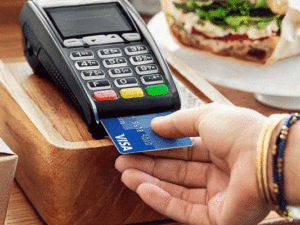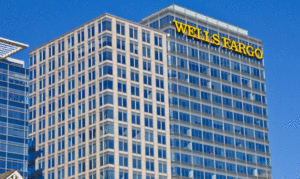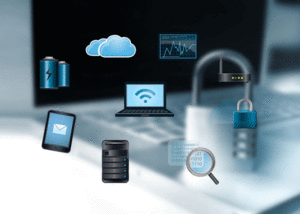Behind the Chip
Published on March 8, 2017, at 8:34 a.m.
by Clara Balestrieri.
“Please insert chip.”
We’re all familiar with hearing this when making a purchase. Sometimes it’s more convenient than using cash and struggling to put the change back in your wallet while the person behind you is patiently waiting. Cyber security is evolving. With the increase in technology and access to more resources than ever before, cyber security is needed now more than ever.

Thank the chip on your credit cards and debit cards for helping you out. Although using the chip may take longer to process, you need to know what it is doing for you.
According to a fact sheet released by Bank of America, “A chip card is a standard-size plastic debit or credit card that contains an embedded microchip as well as a traditional magnetic stripe. The chip encrypts information to help increase data security when making transactions at terminals or ATMs that are chip-enabled.”
The chip gives your cards an extra boost of security. Adam Ghazi-Tehrani, an assistant professor in the Department of Criminology and Criminal Justice at The University of Alabama, explained the importance of the chip.
“The credit card technology most people are familiar with are the magnetic ‘swipe’ cards,” Ghazi-Tehrani said. “These store the owner’s credit card information in an unencrypted and easily accessible format, which makes fraudulently duplicating these cards extremely easy to do. Chip cards have a miniature microchip that makes each card act as its own little computer, storing the sensitive information in a much safer encrypted form. When paying for items at a store, this protects the card from being duplicated illegally.”
Recently, companies have suffered from breaches and hacks. These attacks have affected the individual consumers significantly. Take for example the attack on Yahoo: Nearly one billion accounts were compromised in December 2016. The OPM attack in July 2016 exposed sensitive information on almost 22 million government employees.
According to an article released by WIRED in January of this year, “2017 is set to be a year dominated by just as many data breaches, putting those with the world’s most popular password at a greater risk than ever before.” So what can we, as well as companies, do to protect ourselves?
What can companies do?
Of course, whenever these attacks happen, the company’s public relations teams are put to work. Darci Chan, a former Wells Fargo financial advisor employee in San Francisco, gave some insight on how the company deals with hacks and breaches. “Security for us is incredibly important,” Chan explained. “We have to protect our clients, especially when we’re dealing with massive amounts of money such as their entire life savings.”

New security rules and guidelines can be put into place. Chan said, “It’s very common for us to get an email from an account asking to wire money out so Wells Fargo has put new safeguards in place. New rules such as when we get an email to wire money to certain accounts, we no longer accept emails. Instead we talk verbally and ask questions regarding their account, even if we know them personally.”
Companies’ public relations teams can work together to form campaigns that focus on the dangers of hacking. Wells Fargo released a campaign in May 2016 focusing on the importance of password security.
According to an Advertising Age article published in 2016, “In a new spot designed to highlight Wells Fargo’s new security advancements, a dad is refused entry into his daughters’ make-believe house, and eventually gets through by using the password, ‘Dad’s coming in.’ It’s a good thing all passwords aren’t developed by young girls protecting their fairy caves, but the San Francisco-based bank gets that security is an issue its customers are facing.”
This campaign addresses the importance of security and ties in relatable situations in order to reach out to potentially affected publics. PR plays a huge role in protecting companies and clients. It is our job to communicate regularly with the client and stress the concern of security. Companies should always reassure people to protect their information, such as no longer putting their Social Security number on statements in the mail and shredding those statements once received.
Ghazi-Tehrani also noted, “Companies should listen more to their information security and IT departments; and then be willing to spend money implementing their recommendations. A lot of computer security isn’t difficult, it is just expensive. When corporations want to cut costs in the short run (cheap security), it usually ends up costing much more in the long run (a hack).”
How can you protect yourself?
Ghazi-Tehrani said, “I think the end-user is becoming quite aware of cyber security issues and how to handle them. People with bad passwords and insecure computers are getting attacked with more and more frequency, which is leading to more of the populace being smart. Criminals always go for the ‘low hanging fruit,’ so there will always be victims, but the smart consumers can stay more protected than the rest and usually be OK.”

Darci touched on her passwords: “I have one password for all of my accounts but it is strong and long. I change the last part of the password for each account. I also change my passwords every year.” Changing your password is the first and easiest step in securing your information and protecting yourself.
In addition, next time you’re in a public place, avoid the public Wi-Fi. According to a Tripwire article, “Wait until you have a secure network connection. You will be surprised to find that most hotels’ Wi-Fi is an open connection and does not use end-to-end encryption. Anyone can retrieve the information you enter in your smartphone, tablets, or laptops while using public Wi-Fi.”
Be vigilant and aware of your online activity. Make sure to constantly check your bank statements and accounts to make sure there is no suspicious activity. Cover yourself when you are entering your pin into ATMs or in the checkout lines, and always remember to observe your surroundings.
So, next time you’re waiting for your chip to be read at the checkout line, be patient, and know that it is only there to protect you.




